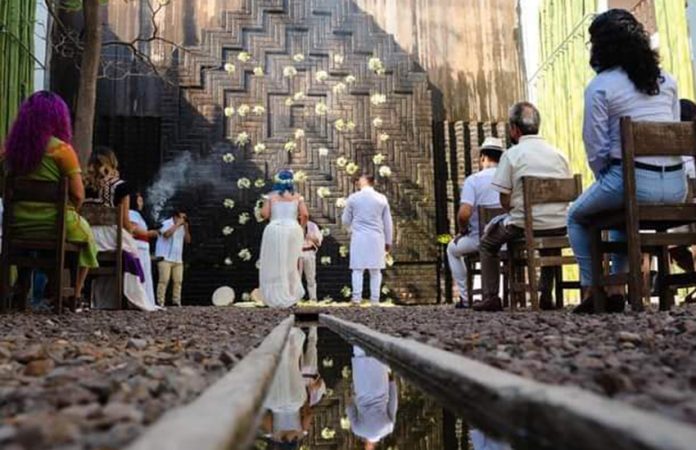Slowly, ever so slowly, people are thinking about returning to the business of living after over 1 1/2 years of the pandemic — and that includes weddings.
All of Mexico’s tourism sectors were hit hard by the pandemic. But destination weddings were devastated, with over 80% of nuptials canceled or postponed since the health emergency began, according to Mexico’s Tourism Ministry in February.
Mexico suffered a double whammy since not only did people not want to travel great distances, harsh restrictions on group gatherings made putting on weddings difficult to impossible.
Before the pandemic, Oaxaca ranked fourth in Mexico for destination weddings, providing couples from out of state and internationally a romantic backdrop to their vows. In Mexico, where federal tourism authorities have been promoting such weddings since 2014, such events were a relatively recent but fast-growing phenomenon. They increased by 50% between 2011, when the government started tracking such weddings, and 2016.
In 2019, the website Destination Weddings listed Mexico as topping the list of foreign wedding locations for “many happy couples who are headed for the altar.”

The majority of couples who typically choose Oaxaca as their nuptials staging ground are from Mexico, but the state is seeing an increasing share of the Americans, Canadians and even Europeans who come to Mexico for the wedding of a lifetime. Oaxaca and the rest of Mexico have been particularly popular with couples looking to elope (the type of wedding that suffered the least during the pandemic), but large weddings and even renewals of vows ceremonies had been steadily increasing.
The paralysis of this industry in 2020 left about 200 businesses in dire straits statewide that are only now starting to recover. Wedding licenses are still being issued in Oaxaca but with strict restrictions related to crowds.
The uptick in bookings for the future gives some hope that these restrictions will soon ease.
Mexico is famous for two types of destination weddings: those by the ocean and those among the majestic buildings of colonial cities. Oaxaca is one of few states that offers both. And despite being a conservative state, some areas of Oaxaca have also been open to gay weddings since 2014 — and more so after the state Congress approved legal weddings of this type in 2019.
Huatulco is the most popular Oaxaca destination for those looking for an oceanside wedding. One reason is its abundance of all-inclusive resorts such as Dreams Huatulco and Secrets Huatulco, which allow for everything to be provided in one place.
One of Huatulco’s unique advantages is its ecotourism, with nine beautiful bays, 36 beaches and lush tropical vegetation. The smaller coastal resort town of Zipolite (famous for its clothing-optional beach) is popular with couples looking for alternative ceremonies and, increasingly, gay weddings.

The inland city of Oaxaca, the state capital, is the main attraction for those looking for backdrops of pre-Hispanic and colonial buildings made of centuries-old massive stone blocks. The city offers sophisticated accommodations and cuisine such as what is found at the Catedral de Oaxaca restaurant, located in a former 19th-century mansion next to the main cathedral.
Coastal weddings in Oaxaca are still more popular among foreigners than those in the state capital, but Adriana Aguilar Escobar of Catedral de Oaxaca says this is changing, with more foreigners returning to the city after being enchanted by it from an earlier visit.
Some hardy souls who have decided not to wait have opted for alternatives such as “pop-up” weddings, initially made popular in Lisbon, Portugal. These are very small affairs of about 15 people lasting only a few hours at most, with the idea that the larger celebration would be held later after the pandemic is over. They have been more common in the Caribbean and San Miguel de Allende, but this type of wedding has been celebrated in Oaxaca as well.
One interesting accommodation of the pandemic was an event sponsored by Oaxaca wedding planner Nancy Romero and the BADABUN video company. Romero is very active in an organization called Oaxaca Ancestral, a non-profit organization seeking to protect and preserve native cultures. They put out a call to couples unable to have a traditional wedding due to the pandemic and offered them a traditional Zapotec ceremony presided by someone accredited by his community to perform it.
Various couples applied. One was chosen based on their reasons for wanting the ceremony.
Such ceremonies are not legal in Mexico (only the civil registry can perform legal weddings), but they are an option for those who feel the need for something spiritual.
A traditional Zapotec ceremony that was offered to a couple unable to have a traditional wedding.
Getting married in Oaxaca is legal and recognized worldwide, but there are certain requirements, both by Mexico and the state of Oaxaca. These requirements vary depending on whether one or both persons are foreigners. Wedding planners are recommended as the process can seem daunting despite the federal requirements being available online in English.
There is no reason to believe that the destination wedding industry in Oaxaca won’t eventually rebound. Mexico continues to be an attractive destination because it has the ability to accommodate large parties traveling to the same place, and Oaxaca offers most of what is available just about anywhere else in Mexico, including pristine beaches, extreme sports, majestic architecture and even Pueblos Mágicos (Magical Towns), which are growing in popularity as wedding backdrops.
In addition, the state offers some of the best-preserved indigenous and other traditional cultures that few other areas in Mexico can match.
Leigh Thelmadatter arrived in Mexico 18 years ago and fell in love with the land and the culture in particular its handcrafts and art. She is the author of Mexican Cartonería: Paper, Paste and Fiesta (Schiffer 2019). Her culture column appears regularly on Mexico News Daily.
